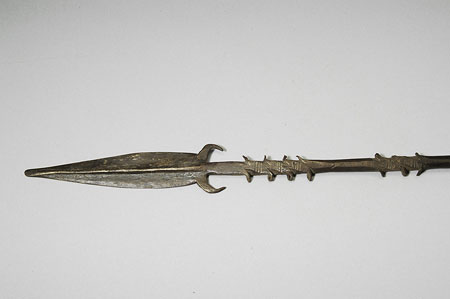Accession Number:
1944.10.26
Country:
Sudan
Region:
Blue Nile ?Darfung
Cultural Group:
?Ingessana
Date Made:
By 1912
Materials:
Iron Metal , Cane Plant
Process:
Forged (Metal) , Hammered , Socketed , Decorated Incised , Carved , Stained
Dimensions:
Total L = 2172; spear-head L = 604; blade L = 177, W = 35, th = 8.7; barbed shank W = 25.4, th = 9.5, socket diam = 23 x 22.7; shaft diam = 20 x 19.3 (upper) and 15 x 14.8 mm (lower) [RTS 18/7/2005].
Weight:
790.7 g
Other Owners:
L. Gorringe and Mrs L. Gorringe
Field Collector:
L. Gorringe
PRM Source:
Mrs L. Gorringe
Acquired:
Donated October 1944
Collected Date:
1902 - 1912
Description:
Spear consisting of an iron spear-head with leaf-shaped blade, slightly splaying at the tip, and ending in 2 broad, flattened barbs curving down and in at its base.
This has a prominent raised rib running down the length on both sides.
Below is a solid shank, of roughly the same length as the blade, the majority of which has been hammered flat and has a rectangular section.
The upper part has been worked along its edges to create 4 sets of barbs, curving upwards on one side and downwards on the opposite edge, with both faces worked in this fashion.
The shank between has been decorated with 3 groups of 3 parallel incised horizontal lines.
This is followed by a short section where the shank has been shaved to give it a slightly octagonal section, then another rectangular section edged with 3 sets of barbs, and decorated with 2 groups of incised lines.
The shank then continues with a solid, oval sectioned body, before opening up into a cylindrical socket that expands towards its base, with a seam running up the front.
The base of this seam has been closed, but it opens again for a short while above that point; the metal is a dull dark gray colour (Pantone 440C).
This fits onto the top of a segmented shaft, carved from a yellowish brown length of cane or bamboo (Pantone 7509C).
This has parts of 6 segments visible along its body, and tapers in slightly towards its lower end.
The spear is nearly complete; the tips of several barbs appear to have broken off the spear-head, especially on the lower section, while the shaft has split near its end.
There are also 5 holes in a row along the body of the shaft that may have been added by the collector or museum when mounting the object.
It has a weight of 790.7 grams and a total length of 2172 mm.
The spear-head is 604 mm long, with a blade length of 177 mm (not including the base barbs), width of 35 mm and thickness of 8.7 mm.
The barbed part of the shank is 25.4 mm wide and 9.5 mm thick, while the socket has a diameter of 22.7 by 23 mm.
The shaft has an upper body diameter of 20 by 19.3 mm and diameter at the butt end of 15 by 14.8 mm.
Collected by L. Gorringe in the Sudan sometime between 1902 and 1912, and donated to the Museum by his widow in October 1944.
Rachael Sparks 30/9/2005.
Collected by L. Gorringe in the Sudan sometime between 1902 and 1912, and donated to the Museum by his widow in October 1944.
Rachael Sparks 30/9/2005.
Primary Documentation:
Accession Book Entry
[p.
375] -
Mrs L.
GORRINGE, Rosaries Farm, Ngong, Kenya
.
Specimens collected by her late husband, Captain L.
Gorringe, M.C., in the ANGLO-EGYPTIAN SUDAN between 1902 and 1912.
Undocumented.
[381] 1944.10.26.
- Spear with socketed iron head, consisting of a small leaf-shaped blade with midrib strongly marked on both sides, at its base two barbs curved downwards, rectangular-sectioned shank with short barbs arranged asymmetrically, viz., on one side higher than on the other, round-sectioned socket expanding towards its mouth; with bamboo shaft.
Total length 7" 1 1/2", length of head 1' 11 3/4".
Same data [Provenance uncertain, probably DAR FUNG] (INGASSANA or BERTA?).
Pitt Rivers Museum label - DAR FUNG, A.E. SUDAN. Coll. by Capt. L. Gorringe, 1902-1912. d.d. Mrs L. Gorringe. 1944.10.26 [rectangular paper label, stuck to surface of object]; AFRICA, Sudan, probably Darfung. Ingessana or Berta? Spear with socketed and barbed iron head, d.d. Mrs L. Gorringe. 1944.10.26 [plastic coated label, tied to object; RTS 14/7/2005].
Pitt Rivers Museum label - DAR FUNG, A.E. SUDAN. Coll. by Capt. L. Gorringe, 1902-1912. d.d. Mrs L. Gorringe. 1944.10.26 [rectangular paper label, stuck to surface of object]; AFRICA, Sudan, probably Darfung. Ingessana or Berta? Spear with socketed and barbed iron head, d.d. Mrs L. Gorringe. 1944.10.26 [plastic coated label, tied to object; RTS 14/7/2005].






